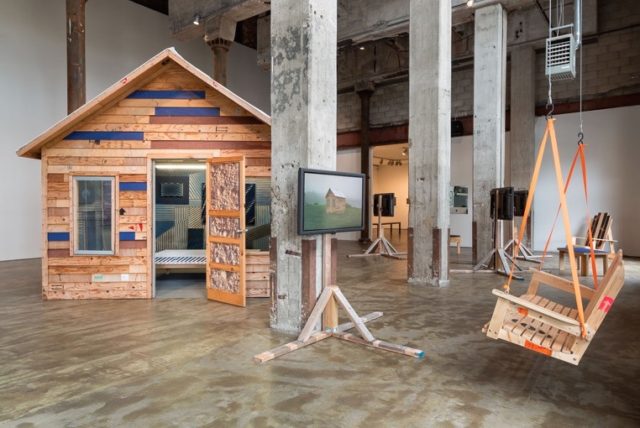
Installation view of Ghost of a Dream’s When the Smoke Clears: The Fair Housing Project at Smack Mellon (Photo by Etienne Frossaard; Courtesy the artists and Smack Mellon)
Can art thrive in the land of startups and $10 coffee? Neither is known to be particularly art friendly, so the question seemed relevant as I headed over to DUMBO. Dotting the neighborhood are several non-profits (and a few for-profit spaces), many of which are beneficiaries of the space subsidy program run by Two Trees, the largest (and arguably only) arts-friendly developer in the city. The program offers these spaces rents at reduced retail prices. (Disclaimer: Art F City is a space subsidy program participant.)
This fall, the proliferation of non-profits in the neighborhood hosts more than its share of politically oriented shows. Following my last gallery round-up in the West Village, I decided to cruise the Brooklyn waterfront on a Saturday afternoon to see what these non-profits to offer for their fall shows. And I was not disappointed. Here’s what I found:
Ghost of a Dream: When the Smoke Clears: The Fair Housing Project
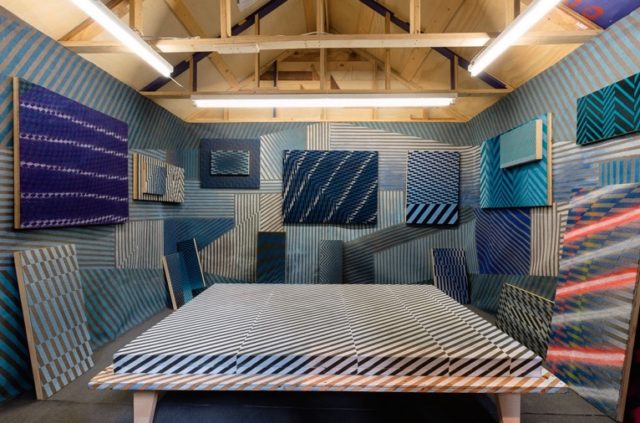
Inside Ghost of a Dream’s Fair Housing Project (Photo by Etienne Frossaard; Courtesy the artists and Smack Mellon)
Smack Mellon
92 Plymouth Street
Brooklyn, NY
On view until October 30, 2016
I never considered the enormous material waste that art fairs generate until I visited Ghost of a Dream’s exhibition When The Smoke Clears: The Fair Housing Project at Smack Mellon.
When The Smoke Clears revives a favorite and, at this point, possibly exhausted art world pastime: criticizing art fairs. Of course, art fairs are easy targets. From the crowded installations to the commodification of the art object and the ridiculousness of its social scene, there’s a lot to complain about.
And yet, the duo’s refreshing focus on the little considered material excess and unsustainability of art fairs revitalizes this old topic. Launched in spectacular fashion, their critique of this excess involves building a life-sized house from leftover fair detritus. To do this, they spent three years gathering materials from dumpsters, hitting fairs like Art Basel Miami, the Armory Show and Frieze. The result of this effort now sits in the center of Smack Mellon.
Titled Fair Housing Project, the piece is made to the size of a traditional art fair booth. Surrounding the house on the periphery of the gallery space are dizzying textured paintings created from art fair rugs and videos of the house in an idyllic lakeside setting. With benches and patio furniture made from art crates scattered around the gallery, it feels like you’re visiting someone’s rural cabin. You almost want to ask the gallery for a glass of iced tea.
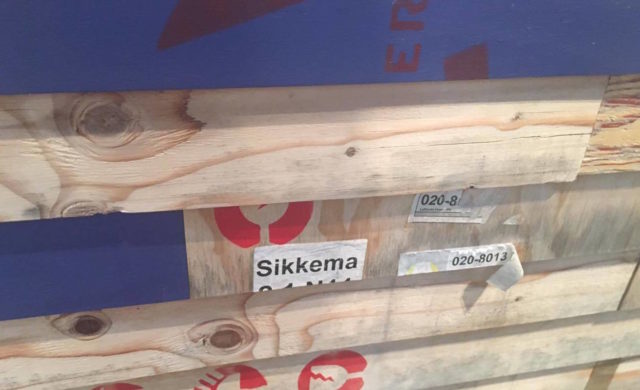
Detail of Fair Housing Project (photo by author)
It should probably go without saying that the house is the main fixture of the show. At first, it appears like any small, reclaimed wooden structure like a model log cabin in a history museum. On closer inspection, Fair Housing Project is covered in recognizable shipping labels and even, legible gallery names. For example, one side of the house is emblazoned with the name Sikkema from Chelsea’s Sikkema Jenkins & Co. I wonder how the gallery feels about their name–and trash–appearing on a shack.
Stepping inside Fair Housing Project is an exercise in overstimulation. The abstractions made of carpet cover almost every available space in the interior–a mockery of the familiar overblown art fair aesthetic. In fairs, this hanging style leaves me just on the edge of a panic attack. The experience is no different here, though it is mitigated by knowing that the sensation is being purposefully evoked. Every abstract carpet design and wall hanging exist to further the viewer’s conceptual and physical understanding of the staggering amount of waste generated by the fairs’ production.
By placing the house both within a gallery space and a natural landscape in the videos, Ghost of a Dream links their critique of fairs with the housing crisis. As New York City’s homeless count hits a record high, how ethical is the sheer material expenditure of art fairs? Could we actually construct houses out of art fair junk to live in? If the house in Smack Mellon is any indication, it may be a viable and potentially necessary option.
Leslie Roberts: FYEO
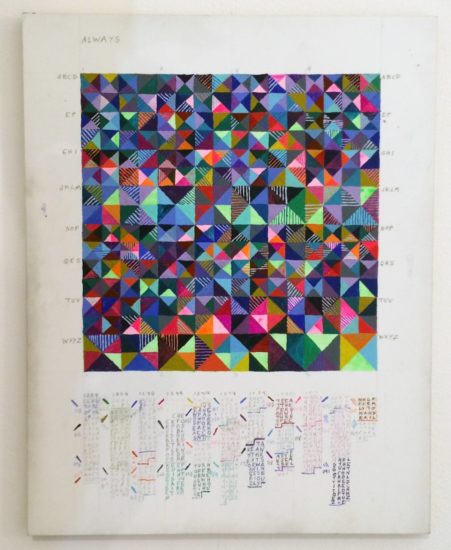
Leslie Roberts, Always, 2016, acrylic gouache, graphite, ink, colored pencil on gessoed panel (Courtesy of the artist and Minus Space)
Minus Space
16 Main Street, Suite A
Brooklyn NY
On view until October 29, 2016
Now here is an exhibition that will make you go blind and it’s not op art. Leslie Roberts’ geometric abstractions come with small text painted below–a key to how the paintings are made–so for those who want to decode the paintings, reading glasses are a must.
While certainly the least political exhibition I saw in DUMBO, Roberts’ show, FYEO, translates the constant barrage of text from our phones, computers, newsfeeds and various other screens into bright geometric abstractions. Her visual puzzles require the viewer’s complete attention.
Each of Roberts’ paintings are split between a block of blinding abstraction with a square of letters at the bottom of each panel. Here Roberts lists a series of phrases, questions, words or thoughts, which correspond to the theme presented by the title in the top left of the painting. Assigning each word or phrase a shape and color, she then transfers these forms into the color-splashed rectangular grid. It’s like Morse code for art-making.
With her seamless decoding of the verbal into the visual, Roberts’ work recalls the mathematical and linguistic interests of Keith Haring’s early works, which also drew on Brion Gysin and William S. Burroughs’ cut-up experiments. While this play with language and image can be a little wonky, both Roberts and Haring manage to surpass its off-putting nerdiness with their word choices. While Haring relied on the hilariously homoerotic “Lick Fat Boys,” what makes Roberts’ work so compelling is her relatable language.
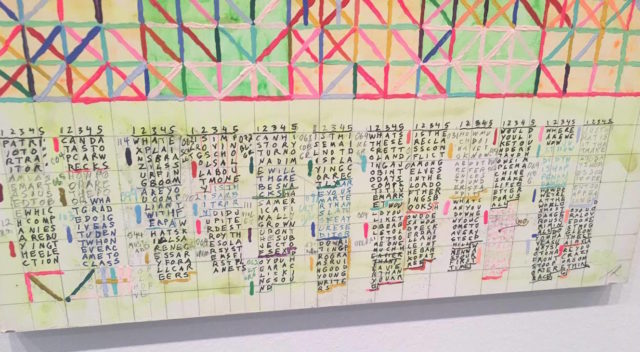
Detail of Leslie Roberts’ Questions, 2015 (photo by author)
Take, for example, her painting Questions, which begins with the query, “Am I as smart as I used to be?” She then follows it with other musings such as “Which companies are buying the election” and the more random, “Can data stop car wrecks?” These questions are so seemingly common and even, mundane that they mirror our own internal monologues and google searches.
To appreciate this sly use of language, Roberts’ work requires active viewing. Writing in tiny block letters smashed together and jumping lines mid-word, you often have to read a line two or three times in order to decipher her phrase. And yet when you do, the entire painting opens up. When so many abstract exhibitions barely require the viewer’s consciousness, Roberts’ viewing challenges feels refreshing. That is, if you’re up for the eyeball strain.


Comments on this entry are closed.